Formulae Handbook for Class 10 Maths and Science
Lakhmir Singh Physics Class 10 Solutions Reflection of Light
Lakhmir Singh Physics Class 10 Solutions Page No:173
Question 1:
What happens when a ray of light falls normally (or perpendicularly) on the surface of a plane mirror ?
Solution :
As ray of light falls normally on mirror, this means that angle of incidence is 0o. From second law of reflection, we know that angle of incidence is equal to angle of reflection. So, angle of reflection will also be zero. Therefore, the light ray will be reflected back along the same path.
Question 2:
A ray of light is incident on a plane mirror at an angle of 30°. What is the angle of reflection ?
Solution :
According to the second law of reflection, angle of incidence is equal to the angle of reflection.
Therefore, angle of reflection=30
0
Question 3:
A ray of light strikes a plane mirror at an angle of 40° to the mirror surface. What will be the angle of reflection ?
Solution :
Angle to the mirror surface=40
0
Therefore, angle of incidence= 90
0
-40
0
=50
0
According to the second law of reflection, angle of incidence is equal to the angle of reflection.
Therefore, angle of reflection=50
0
Question 4:
A ray of light is incident normally on a plane mirror. What will be the :
(a) angle of incidence ?
(b) angle of reflection ?
Solution :
(a) 0
0
(b) 0
0
Question 5:
What type of image is formed :
(a) in a plane mirror ?
(b) on a cinema screen ?
Solution :
(a) Virtual image
(b) Real image
Question 6:
What kind of mirror is required for obtaining a virtual image of the same size as the object ?
Solution :
Plane mirror.
Question 7:
What is the name of the phenomenon in which the right side of an object appears to be the left side of the image in a plane mirror ?
Solution :
Lateral inversion.
Question 8:
Name the phenomenon responsible for the following effect:
When we sit in front of a plane mirror and write with our right hand, it appears in the mirror that we are writing with the left hand.
Solution :
Lateral inversion.
Question 9:
If an object is placed at a distance of 10 cm in from of a plane mirror, how far would it be from its image ?
Solution :
The image is formed behind the mirror at the same distance as the object is kept in front of the mirror.
Given distance between object and mirror=10cm.
Distance between mirror and image=10cm.
Therefore, the distance between object and image=10+10=20cm.
Question 10:
Which property of light makes a pencil cast a shadow when it is held in front of a light source ?
Solution :
Light travels in straight lines.
Question 11:
The image seen in a plane mirror cannot be formed on a screen. What name is given to this type of image ?
Solution :
Virtual image.
Question 12:
Fill in the following blank with a suitable word :
When light is reflected, the angles of incidence and reflection are…………
Solution :
Equal.
Question 13:
State whether the following statement is true or false :
A student says that we can see an object because light from our eyes is reflected back by the object.
Solution :
False.
Question 14:
Where is the image when you look at something in a mirror ?
Solution :
At the back side of mirror.
Question 15
A ray of light strikes a plane mirror such that its angle of incidence is 30°. What angle does the reflected ray make with the mirror surface ?
Solution :
According to the second law of reflection, angle of incidence is equal to the angle of reflection.
Given angle of incidence=30
0
Therefore, angle of reflection=30
0
Angle made by the reflected ray with mirror surface=90
0
-30
0
=60
0
Question 16:
What is the difference between a real image and a virtual image ? Give one example of each type of image.
Solution :
Real image can be obtained on a screen because light rays actually pass through a real image but virtual image cannot be formed on screen because light rays do not actually pass through a virtual image.
Example:-
The image formed on a cinema screen is an example of real image.
The image formed by a plane mirror is a virtual image.
Question 17:
The letter F is placed in front of a plane mirror :
How would its image look like when seen in a plane mirror ?
What is the name of the phenomenon involved ?
Solution :

Question 18:
What is lateral inversion ? Explain by giving a suitable example.
Solution :
When an object is placed in front of a plane mirror, then the right side of the object appears to become the left side of the image; and the left side of the object appears to become right side of the image. This change of the sides of an object and its mirror image is called lateral inversion.
Ex. When we hold a placard having the word RED written on it, as given in fig A, in the front of a plane mirror, the image of the word RED will be as given in fig B.

Question 19:
Write the word AMBULANCE as it would appear when reflected in a plane mirror. Why is it sometimes written in this way (as its mirror image) on the front of an ambulance ?
Solution :

Question 20:
What are the important differences between looking at a photograph of your face and looking at yourself in a plane mirror ?
Solution :
A image of our face in a plane mirror is laterally inverted, so left is right and right is left. However, in a photograph of our face this is not the case.
Lakhmir Singh Physics Class 10 Solutions Page No:174
Question 21:
(a) A wall reflects light and a mirror also reflects light. What difference is there in the way they reflect light ?
(b) Which type of reflection of light leads to the formation of images ?
Solution :
(a) A wall has a rough surface, so the reflection by a wall is a diffuse reflection. A parallel beam of light incident on it is reflected in different directions.
A mirror surface is smooth, so the reflection by a mirror is a regular reflection. A parallel beam of light incident on it, gets scattered by making reflected rays in different directions.
(b) Regular reflection
Question 22:
What is the difference between regular reflection of light and diffuse reflection of light ? What type of reflection of light takes place from :
(a) a cinema screen (b) a plane mirror (c) a cardboard (d) still water surface of a lake
Solution :
In regular reflection, a parallel beam of incident light is reflected as a parallel beam in one direction; while in diffuse reflection, a parallel beam of incident light is reflected in different directions.
(a) Regular reflection
(b) Regular reflection
(c) Diffuse reflection
(d) Regular reflection
Question 23:
What can you see in a completely dark room ? If you switch on an electric bulb in this dark room as a light source, explain how you could now see :
(a) the electric bulb.
(b) a piece of white paper.
Solution :
When we see in a completely dark room, we are not able to see anything because there is no light in the dark room.
(a) We can see bulb due to the light emitted by the bulb.
(b) We can see a piece of white paper because it reflects the light from the bulb falling on it.
Question 24:
(a) A boy with a mouth 5 cm wide stands 2 m away from a plane mirror. Where is his image and how wide is the image of his mouth ?
(b) The boy walks towards the mirror at a speed of 1 m/s. At what speed does his image approach him ?
Solution :
(a) The image will form 2 m behind the mirror and the width of the image of boy’s mouth will be 5 cm.
(b) When the boy walks towards the mirror at a speed of 1 m/s, his image will also appear to move towards the mirror at the same speed of 1 m/s. So, the speed at which his image approach him will be 2 m/s + 2 m/s = 4 m/s.
Question 25:
(a) An extended object in the form of an arrow pointing upward has been placed in front of a plane mirror. Draw a labelled ray-diagram to show the formation of its image.
(b) State the uses of plane mirrors.
Solution :
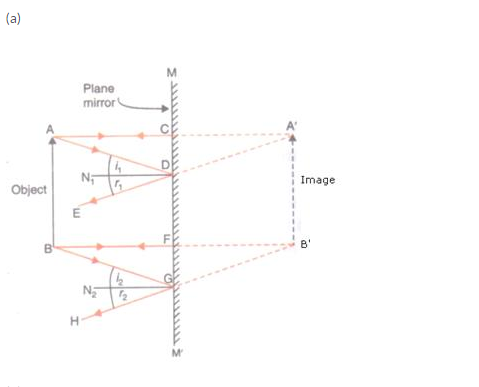
(b) Uses of Plane mirrors:
(i) Plane mirrors are used to see ourselves. The mirrors on our dressing table and in bathrooms are plane mirrors.
(ii) Plane mirrors are fitted at blind turns of some busy roads so that drivers can see the vehicles coming from the other side and prevent accidents.
(iii) Plane mirrors are used to make periscopes.
(iv) Plane mirrors are fixed on the inside walls of certain shops to make them look bigger.
Question 26:
What is meant by ‘reflection of light’ ? Define the following terms used in the study of reflection of light by drawing a labelled ray-diagram :
(a) Incident ray
(b) Point of incidence
(c) Normal
(d) Reflected ray
(e) Angle of incidence
(f) Angle of reflection
Solution :
The process of sending back the light rays which fall on the surface of an object is called reflection of light.
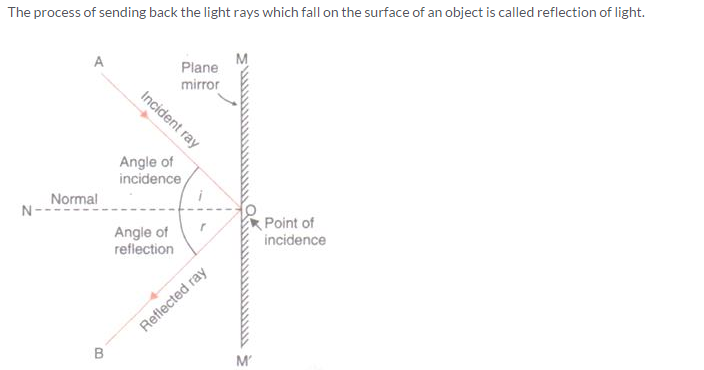
(a) Incident ray: The ray of light that falls on the mirror surface is called the incident ray.
(b) Point of incidence: The point at which the incident ray falls on the mirror is called the point of incidence.
(c) Normal: The normal is a line at right angle to the mirror surface at the point of incidence.
(d) Reflected ray: The ray of light which is sent back by the mirror is called the reflected rays.
(e) Angle of incidence: The angle of incidence is the angle made by the incident ray with the normal at the point of incidence.
(f) Angle of reflection: The angle of reflection is the angle made by the reflected ray with the normal at the point of incidence.
Question 27:
State and explain the laws of reflection of light at a plane surface (like a plane mirror), with the help of a labelled ray-diagram. Mark the angles of ‘incidence’ and ‘reflection’ clearly on the diagram. If the angle of reflection is 47.5°, what will be the angle of incidence ?
Solution :
Laws of reflection of light:
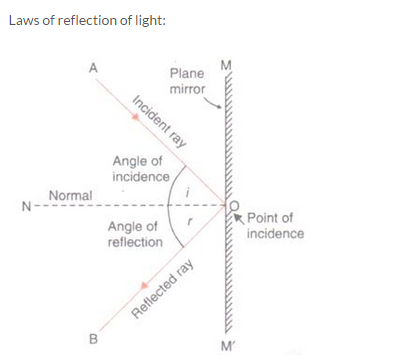
First law of reflection: According to the first law of reflection, the incidence ray, the reflected ray and the normal (at the point of incidence), all lie in the same plane. For e.g., in the figure, the incident ray AO, the reflected ray OB and the normal ON, all lie in the same plane, the plane of paper.
Second law of reflection: According to the second law of reflection, the angle of reflection is always equal to the angle of incidence. For e.g., if we measure the angle of reflection NOB in the figure, we will find that it is exactly equal to the angle of incidence AON.
If the angle of reflection is 47.5o, the angle of incidence will also be 47.5o in accordance with the second law of reflection.
Question 28:
With the help of a labelled ray-diagram, describe how a plane mirror forms an image of a point source of light placed in front of it. State the characteristics of the image formed in a plane mirror.
Solution :
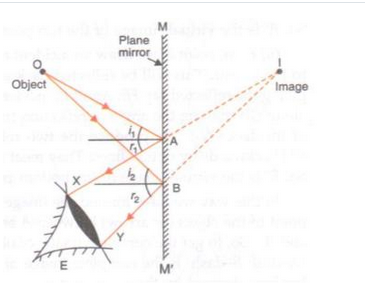
Cosider a point source of light O placed in front of a plane mirror MM’. a ray of light OA coming from O in incident at point A on the mirror and gets reflected in the direction AX according to the laws of reflection of light. Another ray of light OB coming from O strikes the mirror ar point B and gets reflected in the direction BY. Rays AX and BY, on producing backwards, meet at point I behind the mirror; which is the image of point source O.
Characteristics of image formed in a plane mirror:
(i) The image formed in a plane mirror is virtual. It cannot be received on a screen.
(ii) The image formed in a plane mirror is erect. It is the same side up as the object.
(iii) The image in a plane mirror is of the same size as the object.
(iv) The image formed by a plane mirror is at the same distance behind the mirror as the object is in front of the mirror.
(v) The image formed by a plane mirror is laterally inverted.
Question 29:
(a) Explain why, though both a plane mirror and a sheet of paper reflect light but we can see the image of our face in a plane mirror but not in a sheet of paper.
(b) The image in a plane mirror is virtual and laterally inverted. What does this statement mean ?
(c) Write all the capital letters of the alphabet which look the same in a plane mirror.
Solution :
(a) We can see the image of our face in a plane mirror but not in a sheet of paper because images are formed by regular reflection of light and in case of a plane mirror, regular reflection takes place; while in case of a sheet of paper, diffuse reflection takes place.
(b) The image is virtual and laterally inverted means it cannot be obtained on a screen and is reversed sideways.
(c) A, H, I, M, O
Lakhmir Singh Physics Class 10 Solutions Page No:175
Question 36:
A man stands 10 m in front of a large plane mirror. How far must he walk before he is 5 m away from his image ?
Solution :
Initially, the distance between the man and the mirror is 10m.
So, the distance between man and his image is 10+10=20m
Distance between the man and his image is 5 m when the man is 2.5 m away from the mirror.
Therefore, he has to walk 10 m – 2.5m = 7.5 m towards the mirror
Question 37:
An object is placed 20 cm in front of a plane mirror. The mirror is moved 2 cm towards the object. The distance between the positions of the original and final images seen in the mirror is :
(a) 2 cm, (b) 4 cm (c) 10 cm (d) 22 cm
Solution :
Initially, the object is placed 20 cm in front of mirror. So the image will form 20 cm behind the mirror.
If mirror is moved 2 cm towards the object,
distance between object and mirror = 20 cm – 2 cm = 18 cm
distance between mirror and image = 18 cm, which is 2 cm less than the initial case.
Since, the mirror has also moved 2 cm away from the position of original image, so the total distance between the positions of the original and final images is 2 cm + 2 cm = 4 cm
Question 38:
A man sits in an optician’s chair, looking into a plane mirror which is 2 m away from him and views the image of a chart which faces the mirror and is 50 cm behind his head. How far away from his eyes does the chart appear to be ?
Solution :
Distance between the man and the mirror = 2 cm
Distance between man and chart = 50 cm = 0.5 m
Distance between chart and mirror = 0.5 m + 2 m = 2.5 m
Distance between mirror and the image of the chart = 2.5 m
Distance between man and the image of chart = Distance between man and the mirror + Distance between mirror and the image of the chart = 2 m + 2.5 m = 4.5 m
Question 39:
A ray of light strikes a plane mirror PQ at an angle of incidence of 30°, is reflected from the plane mirror and then strikes a second plane mirror QR placed at right angles to the first mirror. The angle of reflection at the second mirror is :
(a) 30° (b) 45° (c) 60° (d) 90°
Draw a ray-diagram to illustrate your answer.
Solution :

Ray AB strikes the mirror PQ at B and gets reflected along BC according to the laws of reflection. The ray BC incident on mirror QR makes an angle of 30o with the mirror. So, the angle of incidence on this mirror is 90o-30o=60o. Hence, the angle of reflection is also 60o.
Question 40:
Explain how to read the following message which was found on some blotting paper :

Solution :
The impression on blotting paper is the mirror image of the written massage. Therefore, to read this message we need to hold the written message in front of a mirror so that the mirror produces a laterally inverted image of this message.
Lakhmir Singh Physics Class 10 Solutions Page No:178
Question 1:
Name the spherical mirror which has :
virtual principal focus.
real principal focus.
Solution :
(a) Convex mirror (b) Concave mirror
Question 2:
Out of convex mirror and concave mirror, whose focus is situated behind the mirror ?
Solution :
Convex mirror
Question 3:
Find the focal length of a concave mirror whose radius of curvature is 32 cm.
Solution :
Radius of curvature (R) = 32cm
Focal length (f) = ?
We know that
f = R/2
=32/2
f = 16cm
Question 4:
If the focal length of a convex mirror is 25 cm, what is its radius of curvature ?
Solution :
Focal length (f) = 25 cm
Radius of curvature (R) = ?
We know that
f = R/2
25=R/2
R= 25 x 2
R = 50 cm.
Lakhmir Singh Physics Class 10 Solutions Page No:179
Question 5:
Fill in the following blanks with suitable words :
Parallel rays of light are reflected by a concave mirror to a point called the………..
The focal length of a concave mirror is the distance from the………. to the mirror.
A concave mirror…….. rays of light whereas a convex mirror……… rays of light.
For a convex mirror, parallel rays of light appear to diverge from a point called the…………
Solution :
(a) principal focus.
(b) principle focus.
(c) converges; diverges.
(d) principle focus.
Question 6:
What is a spherical mirror ? Distinguish between a concave mirror and a convex mirror.
Solution :
A spherical mirror is that mirror whose reflecting surface is the part of a hollow sphere of glass. The spherical mirrors are of two types: concave mirrors and convex mirrors.
Difference between concave mirror and convex mirror:
A concave mirror is that spherical mirror in which the reflection of light takes place at concave surface (or bent-in surface), whereas a convex mirror is that spherical miror in which the reflection of light takes place at the convex surface (or bulging out surface).
Concave mirror converges the parallel rays of light that fall on it, whereas convex mirror diverges the parallel rays of light that fall on it.
Question 7:
Name the two types of spherical mirrors. What type of mirror is represented by the :
(a) back side of a shining steel spoon ?
(b) front side of a shining steel spoon ?
Solution :
Two types of spherical mirrors are:
(i) Concave mirror
(ii) Convex mirror
Type of mirror represented by the:
(a) back side of a shining steel spoon – convex mirror
(b) front side of a shining steel spoon – concave mirror
Question 8:
What is the relation between the focal length and radius of curvature of a spherical mirror (concave mirror or convex mirror) ? Calculate the focal length of a spherical mirror whose radius of curvature is 25 cm.
Solution :
For a spherical mirror the principal focus (F) lies exactly mid-way between the pole (P) and centre of curvature (C). So, the focal length (f) of a spherical mirror is equal to half of its radius of curvature (R).
f=R/2
R= 25cm (Given)
f=?
We know that
f=R/2
=25/2
f =12.5cm
Question 9:
Explain with a suitable diagram, how a concave mirror converges a parallel beam of light rays. Mark clearly the pole, focus and centre of curvature of concave mirror in this diagram.
Solution :
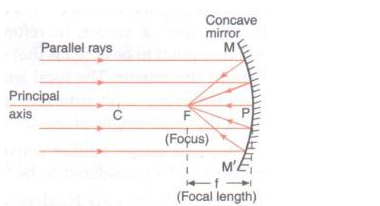
All the light rays which are parallel to the principal axis of a concave mirror, converge at the the principal focus (F) after reflection from the mirror. Since a concave mirror converges a parallel beam of light rays, it is also called a converging mirror.
Question 10:
Describe with a suitable diagram, how a convex mirror diverges a parallel beam of light rays. Mark clearly the pole, focus and centre of curvature of convex mirror in this diagram.
Solution :
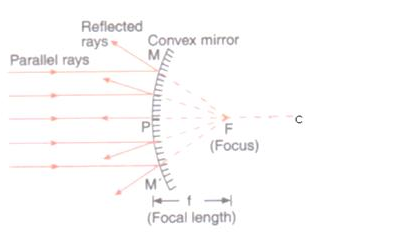
All the light rays which are parallel to the principal axis of a convex mirror, appear to diverge from the principal focus (F) after reflection from the mirror. Since a convex mirror diverges a parallel beam of light rays, it is also called a diverging mirror.
Question 11:
Define (a) centre of curvature (b) radius of curvature (c) pole (d) principal axis, and (e) aperture, of a spherical mirror with the help of a labelled diagram.
Solution :
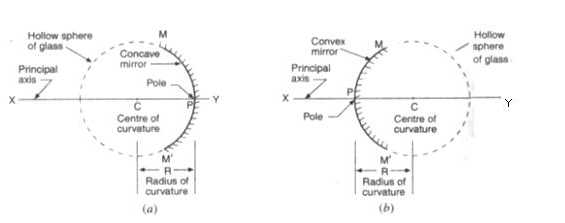
(a) Centre of curvature: Centre of curvature of a spherical mirror is the centre of the hollow sphere of glass of which the mirror is a part.
(b) Radius of curvature: Radius of curvature of a spherical mirror is the radius of the hollow sphere of glass of which the mirror is a part.
(c) Pole: The centre of a spherical mirror is called its pole.
(d) Principal axis: The straight line passing through the centre of curvature and pole of a spherical mirror is called its principal axis.
(e) Aperture: The portion of a mirror from which the reflection of light actually takes place is called the aperture of the mirror.
Question 12:
(a) Define (i) principal focus of a concave mirror, and (ii) focal length of a concave mirror.
Draw diagram to represent the action of a concave mirror on a beam of parallel light rays. Mark on this diagram principal axis, focus F, centre of curvature C, pole P and focal length ƒ, of the concave mirror.
Solution :
(a) (i) Principal focus of a concave mirror: The principal focus of a concave mirror is a point on its principal axis to which all the light rays which are parallel and close to the axis, converge after reflection from the concave mirror.
(ii) Focal length of a concave mirror: The focal length of a concave mirror is the distance between its pole and the principal focus.
(b)
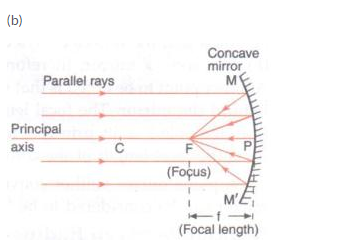
Question 13:
(a) What is meant by (i) principal focus of a convex mirror, and (ii) focal length of a convex mirror ?
(b) Draw diagram to show the action of convex mirror on a beam of parallel light rays. Mark on this diagram principal axis, focus F, centre of curvature C, pole P and focal length ƒ, of the convex mirror.
Solution :
(a) (i) Principal focus of a convex mirror: The principal focus of a convex mirror is a point on its principal axis from which a beam of light rays, initially parallel to the axis, appears to diverge after being reflected from the convex mirror.
(ii) Focal length of a concave mirror: The focal length of a convex mirror is the distance from the pole (P) to its principal focus (F).
(b)
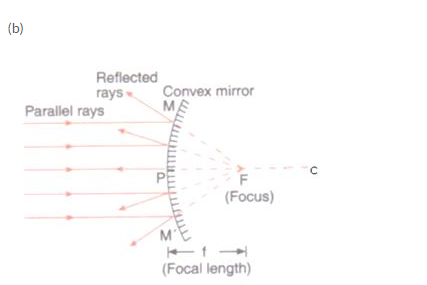
Question 19:
A communications satellite in orbit sends a parallel beam of signals down to earth. If these signals obey the same laws of reflection as light and are to be focussed onto a small receiving aerial, what should be the best shape of the metal ‘dish’ used to collect them ?
Solution :
Concave metal dish: It will collect the parallel beam of satellite signals at its focus where receiving aerial is fixed.
Question 20:
When a spherical mirror is held towards the sun and its sharp image is formed on a piece of carbon paper for some time, a hole is burnt in the carbon paper.
(a) What is the nature of spherical mirror ?
(b) Why is a hole burnt in the carbon paper ?
(c) At which point of the spherical mirror the carbon paper is placed ?
(d) What name is given to the distance between spherical mirror and carbon paper ?
(e) What is the advantage of using a carbon paper rather than a white paper ?
Solution :
(a) Concave mirror
(b) A lot of sun’s heat rays are concentrated at the point of sun’s image which burn the hole in carbon paper.
(c) At the focus.
(d) Focal length.
(e) A black carbon paper absorbs more heat rays and hence burns a hole more easily (than a white paper).
Lakhmir Singh Physics Class 10 Solutions Page No:189
Question 1:
For what position of an object, a concave mirror forms a real image equal in size to the object ?
Solution :
At the centre of curvature.
Question 2:
Where should an object be placed in front of the concave mirror so as to obtain its virtual, erect and magnified image ?
Solution :
Between pole and focus.
Question 3:
For which positions of the object does a concave mirror produce an inverted, magnified and real image ?
Solution :
Between focus and centre of curvature.
Question 4:
If an object is placed at the focus of a concave mirror, where is the image formed ?
Solution :
At infinity.
Question 5:
If an object is at infinity (very large distance) in front of a concave mirror, where is the image formed ?
Solution :
At focus.
Question 6:
For what position of an object, a real and diminished image is formed by a concave mirror ?
Solution :
Beyond the centre of curvature.
Question 7:
Copy this figure in your answer book and show the direction of the light ray after reflection :

Solution :
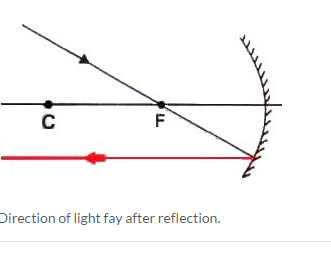
Direction of light fay after reflection.
Question 8:
Draw the following diagram in your answer book and show the formation of image of the object AB with the help of suitable

Solution :
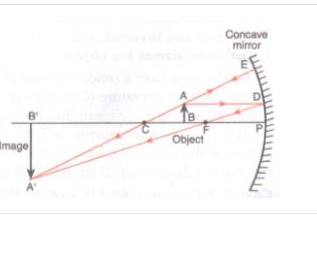
Question 9:
Draw the following diagram in your answer book and show the formation of image with the help of suitable rays

Solution :

Fig. formation of image of AC.
Question 10:
Which type of mirror could be used as a dentist’s mirror ?
Solution :
Concave mirror.
Question 11:
Which kind of mirror is used in the headlights of a car ? Why is it used for this purpose ?
Solution :
Concave mirror is used in the headlights of a car. This is because when a lighted bulb is placed at the focus of a concave mirror reflector, then the diverging light rays of the bulb are collected by the concave reflector and then reflected to produce a strong, parallel-sided beam of light (which travels a considerable distance in the darkness of night).
Question 12:
Explain why, a ray of light passing through the centre of curvature of a concave mirror gets reflected back along the same path.
Solution :
A ray of light passing through the centre of curvature of a concave mirror is reflected back along the same path because it strikes the concave mirror at right angles to its surface due to which the angle of incidence and angle of reflection both are o
o
.
Question 13:
What is the minimum number of rays required for locating the image formed by a concave mirror for an object ? Draw a ray diagram to show the formation of a virtual image by a concave mirror.
Solution :
Minimum two rays are required for locating the image formed by a concave mirror for an object.
Ray diagram for the formation of a virtual image by a concave mirror:
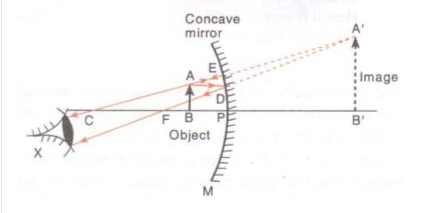
Question 14:
With the help of a ray diagram, determine the position, nature and size of the image formed of an object
placed at the centre of curvature of a concave mirror.
Solution :
When an object is placed at the centre of curvature (C) of a concave mirror, the image formed is:
(i) at the centre of curvature (C),
(ii) real and inverted,
(iii) of same size as the object.
Question 15:
Describe with the help of a diagram, the nature, size and position of the image formed when an object is placed beyond the centre of curvature of a concave mirror.
Solution :
When an object is placed beyond the centre of curvature (C) of a concave mirror, the image is:
(i) between the focus and centre of curvature,
(ii) real and inverted,
(iii) smaller than the object (or diminished).
Question 16:
If an object is placed at a distance of 8 cm from a concave mirror of focal length 10 cm, discuss the nature of the image formed by drawing the ray diagram.
Solution :
The focal length of the mirror is PF = 10 cm.
The object is placed at B such that PB = 8 cm. This means that the object lies between the pole and focus of the concave mirror.
The image formed is virtual, erect and magnified.
Question 17:
Draw a ray diagram showing how a concave mirror can be used to produce a real, inverted and diminished image of an object.
Solution :
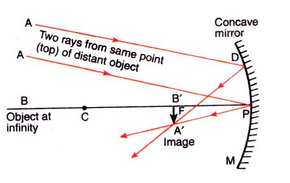
Lakhmir Singh Physics Class 10 Solutions Page No:190
Question 18:
Which mirror is used as a torch reflector ? Draw a labelled diagram to show how a torch reflector can be used to produce a parallel beam of light. Where is the bulb placed in relation to the torch reflector ?
Solution :
Concave mirror is used for a torch reflector.
Diagram:
Bulb is placed at the focus of the torch reflector.
Question 19:
State where an object must be placed so that the image formed by a concave mirror is :
(a) erect and virtual.
(b) at infinity.
(c) the same size as the object.
Solution :
(a) Between pole and focus of the mirror.
(b) At the focus of the mirror.
(c) At the centre of curvature of the mirror.
Question 20:
With the help of a labelled ray diagram, describe how a converging mirror can be used to give an enlarged upright image of an object.
Solution :
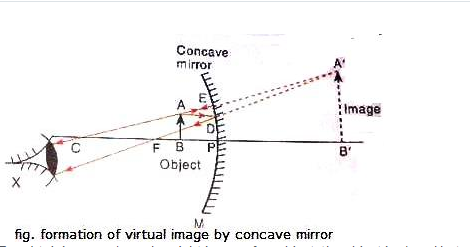
For obtaining an enlarged upright image of an object, the object is placed between focus (F) and pole (P) of the concave mirror.
A ray AD parallel to the principal axis, gets reflected at D and then passes through the focus F. A second ray AE passing through the centre of curvatue C strikes the mirror normally at point E and gets reflected back along the same path.
Now, two reflected rays DF and EC are diverging rays and, therefore, do not intersect each other on the left side. The reflected rays DF and EC are produced backwards (as shown by dotted lines). On producing backwards, they appear to intersect at point A’ behind the concave mirror. Thus, A’ is the virtual image of point A of the object. To get the complete image of the object we draw A’B’ perpendicular to the axis. Thus, A’B’ is the image of the object AB formed by the concave mirror. The image is bigger in size than the object, hence it is an enlarged image.
Question 21:
Make labelled ray diagrams to illustrate the formation of :
(a) a real image by a converging mirror.
(b) a virtual image by a converging mirror.
Mark clearly the pole, focus, centre of curvature and position of object in each case.
Solution :
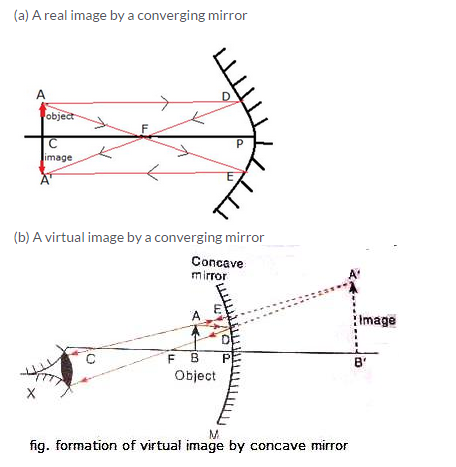
Question 22:
Briefly describe how you would find the focal length of a concave mirror quickly but approximately.
Solution :
When the object is at a considerable distance (or at infinity) from a concave mirror, then its image is formed at the focus. This fact can be used to find out the focal length of a concave mirror quickly but approximately.
We focus a distant object (several metres away) like a window or tree on a screen by using a concave mirror whose focal length is to be determined. The sharp image of window or tree will be formed at the focus of the concave mirror. That is, the distance of image (or screen) from the concave mirror will be equal to the focal length of concave mirror. This distance can be measured with a scale. It will give us the approximate focal length of the concave mirror.
Question 23:
Which type of mirror is used in a solar furnace ? Support your answer with reason.
Solution :
Concave mirror is used in a solar furnace.
The solar furnace is placed at the focus of a large concave reflector. When parallel rays of light from the sun fall on the surface of the concave mirror, rays gets reflected and meet at the focus of the mirror due to the converging nature of concave mirror. Thus, the furnace kept at the focus becomes very hot. Even steel can be melted in this furnace.
Question 24:
Name the type of mirror used by dentists. How does it help ?
Solution :
Concave mirror is used by dentists.
The dentist holds a small concave mirror in such a way that the tooth lies within its focus. A magnified image of the tooth is then seen by the dentist in the concave mirror. Since the tooth looks much bigger, it becomes easy to examine the defect in the tooth.
Question 25:
Explain why, concave mirrors are used as shaving mirrors.
Solution :
Concave mirrors are used as shaving mirrors. This is because when the face is placed close to a concave mirror (so that the face is within its focus) the concave mirror produces a magnified and erect image of the face. Since a large image of the face is seen in the concave mirror, it becomes easier to make a smooth shave.
Question 26:
Give two uses of concave mirrors. Explain why you would choose concave mirrors for these uses.
Solution :
Uses of concave mirror
(i) Concave mirrors are used as shaving mirrors. This is because when the face is placed close to a concave mirror (so that the face is within its focus) the concave mirror produces a magnified and erect image of the face. Since a large image of the face is seen in the concave mirror, it becomes easier to make a smooth shave.
(ii) Concave mirrors are used by dentists to see the large images of the teeth of patients. This is because when a tooth is within the focus of a concave mirror, then an enlarged image of the tooth is seen in the mirror. Due to this, it becomes easier to locate the defect in the tooth.
Question 27:
(a) Draw ray-diagrams to show the formation of images when the object is placed in front of a concave
mirror (converging mirror) :
(i) between its pole and focus
(ii) between its centre of curvature and focus Describe the nature, size and position of the image formed in each case.
(b) State one use of concave mirror based on the formation of image as in case (z) above.
Solution :
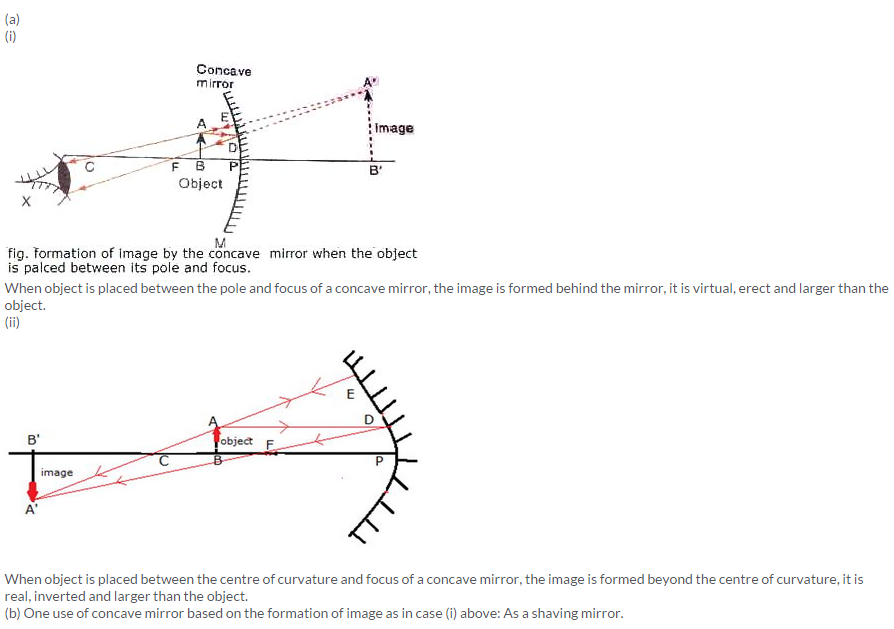
Question 28:
(a) Give two circumstances in which a concave mirror can form a magnified image of an object placed in
front of it. Illustrate your answer by drawing labelled ray diagrams for both.
(b) Which one of these circumstances enables a concave mirror to be used as a shaving mirror ?
Solution :
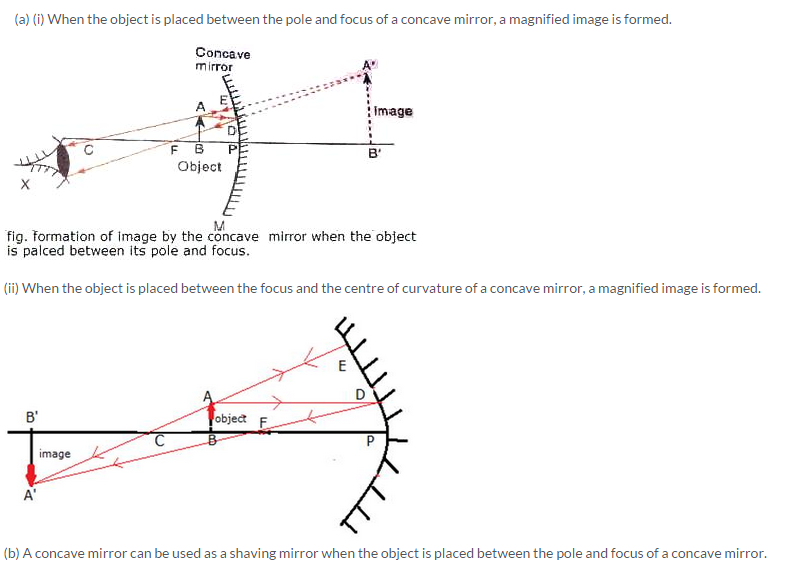
Lakhmir Singh Physics Class 10 Solutions Page No:191
Question 37:
An object is 100 mm in front of a concave mirror which produces an upright image (erect image). The radius of curvature of the mirror is :
(a) less than 100 mm
(b) between 100 mm and 200 mm
(c) exactly 200 mm
(d) more than 200 mm
Solution :
Since the image formed is upright, the object lies within the focus of the concave mirror.
So, f > 100 mm
We know R = 2f
So, R > 200 mm
i.e. Radius of curvature is more than 200 mm.
Question 38:
A virtual, erect and magnified image of an object is to be produced with a concave mirror of focal length 12 cm. Which of the following object distance should be chosen for this purpose ?
(i) 10 cm (ii) 15 cm (iii) 20 cm
Give reasons for your choice.
Solution :
10 cm, because if the object is placed between the pole and focus of the concave mirror only then the image formed is virtual, erect and magnified.
Question 39:
A concave mirror has a focal length of 25 cm. At which of the following distance should a person hold his face from this concave mirror so that it may act as a shaving mirror ?
(a) 45 cm (b) 20 cm (c) 25 cm (d) 30 cm
Give reason for your choice.
Solution :
20 cm, because if the object is placed between the pole and focus of the concave mirror only then the image formed is erect and magnified.
Question 40:
An object is placed at the following distances from a concave mirror of focal length 15 cm, turn by turn :
(a) 35 cm (b) 30 cm (c) 20 cm (d) 10 cm
Which position of the object will produce :
(i) a magnified real image ?
(ii) a magnified virtual image ?
(iii) a diminished real image ?
(iv) an image of same size as the object ?
Solution :
(i) A magnified real image – When the object is placed at a distance of 20 cm from the mirror i.e., between focus and centre of curvature.
(ii) A magnified virtual image – When the object is placed at a distance of 10 cm from the mirror i.e., within its focus.
(iii) A diminished real image – When the object is placed at a distance of 35 cm from the mirror i.e. beyond the centre of curvature.
(iv) An image of same size as the object – When the object is placed at a distance of 30 cm from the mirror i.e., at the centre of curvature.
Lakhmir Singh Physics Class 10 Solutions Page No:192
Question 1:
According to the “New Cartesian Sign Convention” for mirrors, what sign has been given to the focal length of :
(i) a concave mirror ?
(ii) a convex mirror ?
Solution :
(i) Negative
(ii) Positive
Question 2:
Which type of mirror has :
(a) positive focal length ?
(b) negative focal length ?
Solution :
(a) Convex mirror.
(b) Concave mirror.
Question 3:
What is the nature of a mirror having a focal length of, +10 cm ?
Solution :
Convex mirror (since focal length is positive).
Question 4:
What kind of mirror can have a focal length of, – 20 cm ?
Solution :
Concave mirror (since focal length is negative).
Question 5:
Complete the following sentence :
All the distances are measured from the……….. of a spherical mirror.
Solution :
Pole
Question 6:
What sign (+ve or -ve) has been given to the following on the basis of Cartesian Sign Convention ?
(a) Height of a real image.
(b) Height of a virtual image.
Solution :
(a) Negative.
(b) Positive.
Question 7:
Describe the New Cartesian Sign Convention used in optics. Draw a labelled diagram to illustrate this sign convention.
Solution :
According to the New Cartesian Sign Convention:
(i) All the distances are measured from pole of the mirror as origin.
(ii) Distances measured in the same direction as that of incident light are taken as positive.
(iii) Distances measured against the direction of incident light are taken as negative.
(iv) Distances measured upward and perpendicular to the principal axis are taken as positive.
(v) Distance measured downward and perpendicular to the principal axis are taken as negative.
Lakhmir Singh Physics Class 10 Solutions Page No:193
Question 8:
Giving reasons, state the ‘signs’ (positive or negative) which can be given to the following :
(a) object distance (u) for a concave mirror or convex mirror
(b) image distances (v) for a concave mirror
(c) image distances (v) for a convex mirror
Solution :
(a) Object distance (u) for a concave mirror or convex mirror is always negative because an object is always placed to the left side of the mirror and the distances towards the left of the mirror are always negative.
(b) In case of a concave mirror, if the image is formed on the left side of the mirror, then the image distance (v) will be negative and if the image is formed on the right side of the mirror, then the image distance (v) will be positive. This is because distances measured to the left of the mirror are negative and to the right of the mirror is positive.
(c) Image distances (v) for a convex mirror is always positive because the image is always formed behind the mirror.
Lakhmir Singh Physics Class 10 Solutions Page No:198
Question 1:
If the magnification of a body of size 1 m is 2, what is the size of the image ?
Solution :

Question 2:
What is the position of the image when an object is placed at a distance of 20 cm from a concave mirror of focal length 20 cm ?
Solution :

Question 3:
What is the nature of image formed by a concave mirror if the magnification produced by the mirror is (a) + 4, and (b) -2 ?
Solution :

Question 4:
State the relation between object distance, image distance and focal length of a spherical mirror (concave mirror or convex mirror).
Solution :

Question 5:
Write the mirror formula. Give the meaning of each symbol which occurs in it.
Solution :

Question 6:
What is the ratio of the height of an image to the height of an object known as ?
Solution :
![]()
Question 7:
Define linear magnification produced by a mirror.
Solution :
![]()
Question 8:
Write down a formula for the magnification produced by a concave mirror.
(a) in terms of height of object and height of image
(b) in terms of object distance and image distance
Solution :

Question 9:
Describe the nature of image formed when the object is placed at a distance of 20 cm from a concave mirror of focal length 10 cm.
Solution :

Question 10:
Fill in the following blanks with suitable words :
(a) If the magnification has a plus sign, then image is…………. and……….
(b) If the magnification has a minus sign, then the image is……….. and……….
Solution :
![]()
Question 11:
An object is placed at a distance of 10 cm from a concave mirror of focal length 20 cm.
(a) Draw a ray diagram for the formation of image.
(b) Calculate the image distance.
(c) State two characteristics of the image formed.
Solution :
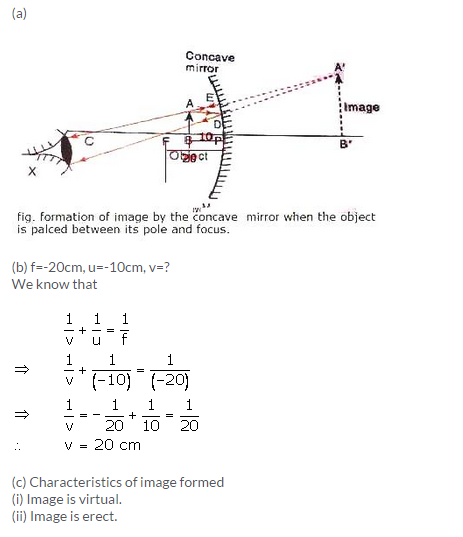
Question 12:
If an object of 10 cm height is placed at a distance of 36 cm from a concave mirror of focal length 12 cm, find the position, nature and height of the image.
Solution :

Question 13:
At what distance from a concave mirror of focal length 10 cm should an object 2 cm long be placed in order to get an erect image 6 cm tall ?
Solution :

Question 14:
When an object is placed at a distance of 15 cm from a concave mirror, its image is formed at 10 cm in front of the mirror. Calculate the focal length of the mirror.
Solution :

Question 15:
An object 3 cm high is placed at a distance of 8 cm from a concave mirror which produces a virtual image 4.5 cm high :
(i) What is the focal length of the mirror ?
(ii) What is the position of image ?
(iii) Draw a ray-diagram to show the formation of image.
Solution :

Question 16:
A converging mirror forms a real image of height 4 cm of an object of height 1 cm placed 20 cm away from the mirror :
(i) Calculate the image distance.
(ii) What is the focal length of the mirror ?
Solution :

Question 17:
An object of size 7.0 cm is placed at 27 cm in front of a concave mirror of focal length 18 cm. At what distance from the mirror should a screen be placed so that a sharp focussed image can be obtained ? Find the size and nature of image.
[Hint. Find the value of image distance (v) first. The screen should be placed from the mirror at a distance equal to image distance].
Solution :

Lakhmir Singh Physics Class 10 Solutions Page No:199
Question 18:
An object 3 cm high is placed at a distance of 10 cm in front of a converging mirror of focal length 20 cm. Find the position, nature and size of the image formed.
Solution :

Question 19:
A concave mirror has a focal length of 4 cm and an object 2 cm tall is placed 9 cm away from it. Find the nature, position and size of the image formed.
Solution :

Question 20:
When an object is placed 20 cm from a concave mirror, a real image magnified three times is formed. Find :
(a) the focal length of the mirror.
(b) Where must the object be placed to give a virtual image three times the height of the object ?
Solution :

Question 21:
A dentist’s mirror has a radius of curvature of 3 cm. How far must it be placed from a small dental cavity to give a virtual image of the cavity that is magnified five times ?
Solution :

Question 22:
A large concave mirror has a radius of curvature of 1.5 m. A person stands 10 m in front of the mirror. Where is the person’s image ?
Solution :

Question 23:
An object of 5.0 cm size is placed at a distance of 20.0 cm from a converging mirror of focal length 15.0 cm. At what distance from the mirror should a screen be placed to get the sharp image ? Also calculate the size of the image.
Solution :

Question 24:
A concave mirror produces three times enlarged virtual image of an object placed at 10 cm in front of it. Calculate the radius of curvature of the mirror.
Solution :

Question 25:
A bright object 50 mm high stands on the axis of a concave mirror of focal length 100 mm and at a distance of 300 mm from the concave mirror. How big will the image be ?
Solution :

Question 26:
How far should an object be placed from the pole of a converging mirror of focal length 20 cm to form a real image of the size exactly \(\frac{1}{4}\) th the size of the object ?
Solution :

Question 27:
When an object is placed at a distance of 50 cm from a concave spherical mirror, the magnification produced
is, \(-\frac{1}{2}\) Where should the object be placed to get a magnification of, \(-\frac{1}{5}\)?
Solution :

Question 28:
An object is placed (a) 20 cm, (b) 4 cm, in front of a concave mirror of focal length 12 cm. Find the nature and position of the image formed in each case.
Solution :
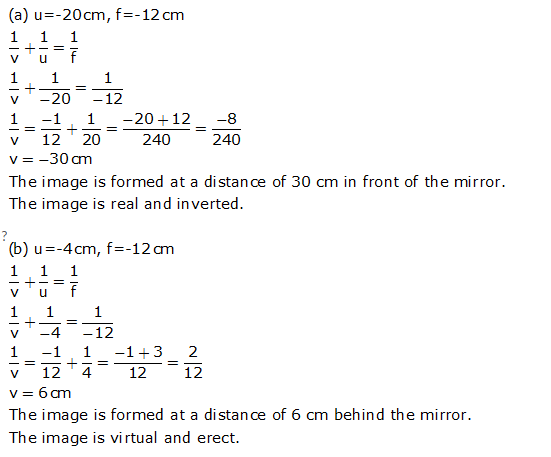
Question 29:
A concave mirror produces a real image 1 cm tall of an object 2.5 mm tall placed 5 cm from the mirror. Find the position of the image and the focal length of the mirror.
Solution :

Question 30:
A man holds a spherical shaving mirror of radius of curvature 60 cm, and focal length 30 cm, at a distance of 15 cm, from his nose. Find the position of image, and calculate the magnification.
Solution :

Question 31:
(a) An object is placed just outside the principal focus of concave mirror. Draw a ray diagram to show how the image is formed, and describe its size, position and nature.
(b) If the object is moved further away from the mirror, what changes are there in the position and size of the image ?
(c) An object is 24 cm away from a concave mirror and its image is 16 cm from the mirror. Find the focal length and radius of curvature of the mirror, and the magnification of the image.
Solution :

Lakhmir Singh Physics Class 10 Solutions Page No:200
Question 42:
Between which two points of concave mirror should an object be placed to obtain a magnification of:
(a) -3 (b) +2.5 (c) – 0.4
Solution :
(a) Between focus and centre of curvature.
(b) Between pole and focus.
(c) Beyond the centre of curvature
Question 43:
At what distance from a concave mirror of focal length 10 cm should an object be placed so that:
(a) its real image is formed 20 cm from the mirror ?
(b) its virtual image is formed 20 cm from the mirror ?
Solution :

Question 44:
If a concave mirror has a focal length of 10 cm, find the two positions where an object can be placed to give, in each case, an image twice the height of the object.
Solution :

Question 45:
A mirror forms an image which is 30 cm from an object and twice its height.
(a) Where must the mirror be situated ?
(b) What is the radius of curvature ?
(c) Is the mirror convex or concave ?
Solution :

Lakhmir Singh Physics Class 10 Solutions Page No:205
Question 1:
What type of image/images are formed by :
(a) a convex mirror ?
(b) a concave mirror ?
Solution :
(a) Virtual and erect
(b) Virtual and erect; real and inverted
Question 2:
Which mirror has a wider field of view ?
Solution :
Convex mirror has a wider field of view.
Question 3:
If you want to see an enlarged image of your face, state whether you will use a concave mirror or a convex mirror ?
Solution :
Concave mirror.
Question 4:
Which mirror always produces a virtual, erect and diminished image of an object ?
Solution :
Convex mirror always produces a virtual, erect and diminished image.
Question 5:
An object is placed at a long distance in front of a convex mirror of radius of curvature 30 cm. State the position of its image.
Solution :
Image is formed at the focus.
focus = 30/2 = 15 cm
i.e. 15 cm behind the convex mirror.
Question 6:
Name the spherical mirror which can produce a real and diminished image of an object.
Solution :
Concave mirror.
Question 7:
Name the spherical mirror which can produce a virtual and diminished image of an object.
Solution :
Convex mirror.
Question 8:
One wants to see a magnified image of an object in a mirror. What type of mirror should one use ?
Solution :
Concave mirror should be used to get a magnified image.
Question 9:
Name the mirror which can give :
(a) an erect and enlarged image of an object.
(b) an erect and diminished image of an object.
Solution :
(a) Concave mirror.
(b) Convex mirror.
Question 10:
State whether the following statement is true or false :
A diverging mirror is used as a rear-view mirror.
Solution :
True.
Question 11:
What type of mirror could be used :
(a) as a shaving mirror ?
(b) as a shop security mirror ?
Solution :
(a) Concave mirror.
(b) Convex mirror.
Question 12:
Which type of mirror is usually used as a rear-view mirror in motor cars ?
Solution :
Convex mirror.
Question 13:
What kind of mirrors are used in big shopping centres to watch the activities of the customers ?
Solution :
Convex mirrors.
Question 14:
A ray of light going towards the focus of a convex mirror becomes parallel to the principal axis after reflection from the mirror. Draw a labelled diagram to represent this situation.
Solution :
diagram 47.
Question 15:
Fill in the following blank with a suitable word :
A ray of light which is parallel to the principal axis of a convex mirror, appears to be coming from…….. after
reflection from the mirror.
Solution :
focus.
Question 16:
Why does a driver prefer to use a convex mirror as a rear-view mirror in a vehicle ?
Solution :
A driver prefers to use a convex mirror as a rear-view mirror because
(i) A convex mirror always produces an erect image of the objects.
(ii) A convex mirror has wider field of view.
Question 17:
Why can you not use a concave mirror as a rear-view mirror in vehicles ?
Solution :
We cannot use a concave mirror as a rear-view mirror in vehicles because a concave mirror produces inverted images of distant objects. So, all the vehicles will be seen running upside down in the mirror.
Question 18:
Where would the image be formed by a convex mirror if the object is placed :
(a) between infinity and pole of the mirror ?
(b) at infinity ?
Draw labelled ray-diagrams to show the formation of image in both the cases.
Solution :
(a) Image will form between pole and focus.
(b) At focus.
Lakhmir Singh Physics Class 10 Solutions Page No:206
Question 19:
The shiny outer surface of a hollow sphere of aluminium of radius 50 cm is to be used as a mirror :
(a) What will be the focal length of this mirror ?
(b) Which type of spherical mirror will it provide ?
(c) State whether this spherical mirror will diverge or converge light rays.
Solution :
(a) R=50cm
f=?
We know that
f=R/2 = 50/2 = 25 cm
(b) Convex mirror
(c) It will diverge light rays.
Question 20:
What is the advantage of using a convex mirror as a rear-view mirror in vehicles as compared to a plane mirror ? Illustrate your answer with the help of labelled diagrams.
Solution :

Question 21:
Give two uses of a convex mirror. Explain why you would choose convex mirror for these uses.
Solution :
Two uses of convex mirror:
(i) A convex mirror is used as a rear-view mirror in vehicles because it forms erect and dimished images of the objects and has a wider field of view.
(ii) Big convex mirrors are used as security mirror in shops so that a large number of goods displayed in the shop can be seen in the convex mirror.
Question 22:
What would your image look like if you stood dose to a large :
(a) convex mirror ?
(b) concave mirror ?
Give reasons for your answer.
Solution :
(a) Our image will be diminished, virtual and erect. This is because when the object lies anywhere between the pole and inifinity, the concave mirror forms a diminished, virtual and erect image.
(b) Our image will be enlarged, virtual and erect. This is because when the object lies within the focus of a concave mirror, it forms an enlarged, virtual and erect image.
Question 23:
Which of the following are concave mirrors and which convex mirrors ?
Shaving mirrors, Car headlight mirror, Searchlight mirror, Driving mirror, Dentist’s inspection mirror, Torch mirror, Staircase mirror in a double-decker bus, Make-up mirror, Solar furnace mirror, Satellite TV dish, Shop security mirror.
Solution :
Shaving mirror – concave mirror.
Car headlight mirror – concave mirror.
Searchlight mirror – concave mirror.
Driving mirror – convex mirror.
Dentist’s inspection mirror – concave mirror.
Torch mirror – concave mirror.
Staircase mirror in a double-decker bus – convex mirror.
Make-up mirror – concave mirror.
Solar furnace mirror – concave mirror.
Satellite TV dish – concave mirror.
Shop security mirror – convex mirror.
Question 24:
How will you distinguish between a plane mirror, a concave mirror and a convex mirror without touching them ?
Solution :
We can distinguish between a plane mirror, a concave mirror and a convex mirror by bringing our face close to each mirror, turn by turn. If the image is of the same size as our face, it is a plane mirror. If the image is magnified, it is a concave mirror. If the image is diminished, it is a convex mirror.
Question 25:
If a driver has one convex and one plane rear-view mirror, how would the images in each mirror appear different ?
Solution :
The images formed in the convex rear-view mirror will be smaller than those formed in the plane rear-view mirror.
Question 26:
(a) Draw a labelled ray diagram to show the formation of image of an object by a convex mirror. Mark
clearly the pole, focus and centre of curvature on the diagram.
(b) What happens to the image when the object is moved away from the mirror gradually ?
(c) State three characteristics of the image formed by a convex mirror.
Solution :
(a) Virtual and erect.
(b) Virtual and erect; real and inverted.
Question 27:
(a) Draw a labelled ray diagram to show the formation of image in a convex mirror when the object is at
infinity. Mark clearly the pole and focus of the mirror in the diagram.
(b) State three characteristics of the image formed in this case.
(c) Draw diagram to show how a convex mirror can be used to give a large field of view.
Solution :
Lakhmir Singh Physics Class 10 Solutions Page No:207
Question 37:
The diagrams show the appearance of a fork when placed in front of and close to two mirrors A and B, turn by turn.
(a) Which mirror is convex?
(b) Which mirror is concave?
Give reasons for your choice.

Solution :
(a) Mirror B is convex since it forms a smaller image of fork.
(b) Mirror A is concave since it forms a larger image of fork.
Question 38:
The diagram shows a dish antenna which is used to receive television signals from a satellite. The antenna (signal detector) is fixed in front of the curved dish.
(a) What is the purpose of the dish?
(b) Should it be concave or convex?
(c) Where should the antenna be positioned to receive the strongest possible signals?
(d) Explain what change you would expect in the signals if a larger dish was used.

Solution :
(a) The purpose of the dish is to collect a large amount of TV signals from the satellite.
(b) Concave.
(c) At the focus of the dish.
(d) Stronger signals will be received.
Question 39:
A man standing in front of a special mirror finds his image having a very small head, a fat body and legs of normal size. What is the shape of :
(a) top part of the mirror ?
(b) middle part of the mirror ?
(c) bottom part of the mirror ?
Give reasons for your choice.
Solution :
(a) Convex – Because a convex mirror forms a diminished image when the object is placed near it.
(b) Concave – Because a concave mirror forms an enlarged image when the object is placed near it.
(c) Plane – Because a plane mirror forms an image of same size as the object.
Question 40:
Two big mirrors A and B are fitted side by side on a wall. A man is standing at such a distance from the wall that he can see the erect image of his face in both the mirrors. When the man starts walking towards the mirrors, he finds that the size of his face in mirror A goes on increasing but that in mirror B remains the same
(a) mirror A is concave and mirror B is convex
(b) mirror A is plane and mirror B is concave
(c) mirror A is concave and mirror B is convex
(d) mirror A is convex and mirror B is plane
Solution :
(c) Mirror A is concave and mirror B is concave
Lakhmir Singh Physics Class 10 Solutions Page No:209
Question 1:
An object is kept at a distance of 5 cm in front of a convex mirror of focal length 10 cm. Calculate the position and magnification of the image and state its nature.
Solution :

Question 2:
An object is placed at a distance of 10 cm from a convex mirror of focal length 5 cm.
Draw a ray-diagram showing the formation of image.
State two characteristics of the image formed.
Calculate the distance of the image from mirror.
Solution :

Question 3:
An object is placed at a distance of 6 cm from a convex mirror of focal length 12 cm. Find the position and nature of the image.
Solution :

Question 4:
An object placed 20 cm in front of a mirror is found to have an image 15 cm (a) in front of it, (b) behind the mirror. Find the focal length of the mirror and the kind of mirror in each case.
Solution :

Question 5:
An arrow 2.5 cm high is placed at a distance of 25 cm from a diverging mirror of focal length 20 cm. Find the nature, position and size of the image formed.
Solution :

Question 6:
A convex mirror used as a rear-view mirror in a car has a radius of curvature of 3 m. If a bus is located at a distance of 5 m from this mirror, find the position of image. What is the nature of the image ?
Solution :

Question 7:
A diverging mirror of radius of curvature 40 cm forms an image which is half the height of the object. Find the object and image positions.
Solution :

Question 8:
The radius of curvature of a convex mirror used as a rear view mirror in a moving car is 2.0 m. A truck is coming from behind it at a distance of 3.5 m. Calculate (a) position, and (b) size, of the image relative to the size of the truck. What will be the nature of the image ?
Solution :

Question 9:
(a) Draw a diagram to represent a convex mirror. On this diagram mark principal axis, principal focus F
and the centre of curvature C if the focal length of convex mirror is 3 cm.
(b) An object 1 cm tall is placed 30 cm in front of a convex mirror of focal length 20 cm. Find the size and position of the image formed by the convex mirror.
Solution :

Question 10:
A shop security mirror 5.0 m from certain items displayed in the shop produces one-tenth magnification.
(a) What is the type of mirror ?
(b) What is the radius of curvature of the mirror ?
Solution :

Lakhmir Singh Physics Class 10 Solutions Page No:210
Question 11:
An object is placed 15 cm from (a) a converging mirror, and (b) a diverging mirror, of radius of curvature 20 cm. Calculate the image position and magnification in each case.
Solution :

Question 12:
An object 20 cm from a spherical mirror gives rise to a virtual image 15 cm behind the mirror. Determine the magnification of the image and the type of mirror used.
Solution :

NCERT SOlutions In Video
RD Sharma Class 10 Solutions
CBSE Sammple Papers For Class 10 Maths
CBSE Sammple Papers For Class 10 Science